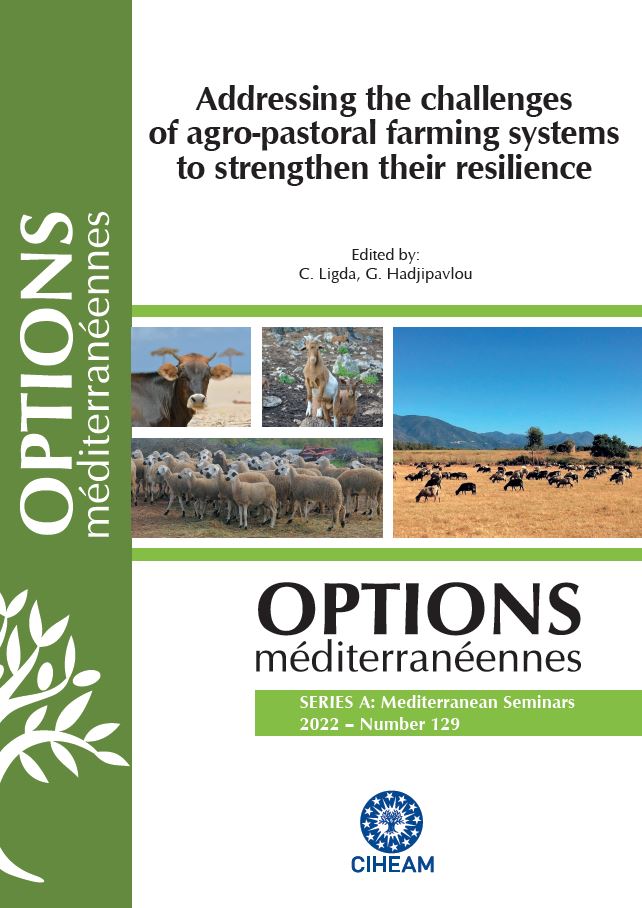| Article précédent | p. 41-48 | Article suivant |
Benefits from recent and on-going projects on adaptation and resilience in French dairy sheep and goats
In France, dairy sheep and goats have developed efficient breeding schemes, whose annual genetic gain ranges from 0.10 to 0.27 genetic standard deviation of the total merit index, according to the breeds. From 2015 to 2020, the 5 dairy sheep breeds and 2 main dairy goat breeds have shifted to full genomic programs, based on reference population constituted of AI progeny-tested males. Currently, the breeding goals are similar for almost all the selected breeds and may be per se qualified as balanced, since they include efficiency criteria (milk yield and content), resilience criteria (udder health, resistance to scrapie), and adaptation to mechanic milking in order to mitigate the workload of the farmer in the milking parlour (udder morphology). There are increasing expectations for improving sustainability, robustness and resilience while still increasing efficiency. These new objectives are emphasized by the different stakeholders: the farmers, the industry, but also the consumers, the citizens. Opportunities occur to cope with these requests: a larger efficiency of selection offered by genomic programs allowing to consider new traits to select, new technologies and methods to limit the phenotyping costs (eg. use of MIR spectra), awareness and consent of all stakeholders to bring new challenges at the agenda (climate change, growing resistance to antibiotics or anthelmintics). Various recent or on-going projects (eg. iSAGE, RUSTIC, ARDI, SMARTER) are addressing the topics of adaptation, sustainability, resilience in small ruminants. Through the French dairy sheep and goat illustration, we propose to explore the following ways, that are the core objectives of the on-going SMARTER project: breeding for new efficiency and resilience traits in a context of more agro-ecological systems and pursuit of self-sufficiency in the feeding systems; benefiting from international harmonization and cooperation; tackling the genotype x environment interactions; sharing the ideas and solutions across the wider range of stakeholders.
En France, les brebis et chèvres laitières bénéficient de schémas de sélection efficaces, dont le progrès génétique annuel varie, selon la race, entre 0.10 et 0.27 écart-type génétique. De 2015 à 2020, les 5 races ovines laitières et les 2 races caprines en sélection ont basculé vers des schémas de sélection génomiques, basés sur des populations de référence constituées de mâles d’IA testés sur descendance. Actuellement, les objectifs de sélection, assez similaires d’une race à l’autre, peuvent être qualifiés d’équilibrés, car ils incluent des critères de production et d’efficience (quantité et richesse du lait), des critères de résilience (santé de la mamelle, résistance à la tremblante) et d’adaptation à la traite mécanique (morphologie de la mamelle). Des attentes, soutenues par l’ensemble des acteurs des filières, sont fortes pour améliorer la durabilité, la robustesse, la résilience tout en améliorant l’efficience des animaux. Des opportunités existent pour traiter ces demandes : plus grande efficacité de la sélection offerte par la génomique, nouvelles technologies ou méthodes, prise de conscience et consentement des acteurs pour mettre en avant ces nouveaux challenges (changement climatique, résistance aux antibiotiques et aux anthelminthiques). Plusieurs projets, récents ou en cours (ex. iSAGE, RUSTIC, ARDI, SMARTER), abordent les questions d’adaptation, de durabilité et de résilience en petits ruminants. Au travers de l’exemple des chèvres et brebis laitières françaises, nous proposons de baliser les thèmes suivants, qui sont au cœur du projet SMARTER: la sélection de nouveaux caractères d’efficience et de résilience dans une contexte d’intérêt croissant pour des systèmes plus agro-écologiques, recherchant plus d’autonomie alimentaire; l’intérêt de l’harmonisation et de la coopération internationale; les interactions génotypes x milieu ; la partage des idées et des solutions par un large réseau d’acteurs et d’utilisateurs de la génétique et de la production de petits ruminants.
- [ Afficher ]
- [ Télécharger ]
- [ Exporter la citation ]
Vous pouvez télécharger la citation au format :
- [ Imprimer ]
-
Mots-clés
ADAPTATION, ANIMAL LAITIER, CHEVRE, OVIN, SELECTIONCiter cet article
Astruc J.M., Buisson D., Clément V., Lagriffoul G., Larroque H., Legarra A., Palhière I., Ugarte E., Moreno-Romieux C. Benefits from recent and on-going projects on adaptation and resilience in French dairy sheep and goats. In : Hadjipavlou G. (ed.), Ligda C. (ed.). Addressing the challenges of agro-pastoral farming systems to strengthen their resilience. Zaragoza : CIHEAM, 2022. p. 41-48. (Options Méditerranéennes : Série A. Séminaires Méditerranéens; n. 129). 71. Annual Meeting of the European Federation of Animal Science, 2021/12/03, Online. http://om.ciheam.org/om/pdf/a129/00008095.pdf



